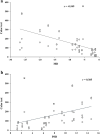Quantitative visual tests in primary open-angle glaucoma patients according to three different lights with different color-rendering index
- PMID: 34049514
- PMCID: PMC8161653
- DOI: 10.1186/s12886-021-02005-2
Quantitative visual tests in primary open-angle glaucoma patients according to three different lights with different color-rendering index
Abstract
Purpose: To compare quantitative visual tests, such as visual acuity, contrast sensitivity, and color vision tests in patients with primary open-angle glaucoma (POAG) patients according to three different light systems with different color-rendering index (CRI).
Methods: This was a cross-sectional study of 36 eyes in 36 patients with POAG. Three different light systems consisting of a 3-band fluorescent lamp (CRI 80), a white LED (CRI 75), and a quantum dot LED (CRI > 95) were used. All lights had the same illuminance of 230 lx to exclude illuminance effects. The visual testing included best-corrected visual acuity (BCVA) using an ETDRS chart, a CSV-1000E contrast test, and a color test performed by the Farnsworth Munsell 100-hue test.
Results: There was no significant difference in BCVA (p = 0.86). There were no significant differences in the detail contrast tests according to the three light systems (p = 0.95, p = 0.94, p = 0.94, respectively, p = 0.64). There was significant difference between the three light systems in color test (p = 0.042). The color test scores with a quantum dot LED were significantly lower than those of the white LED and 3-band fluorescent lamp (p = 0.03 and 0.047, respectively).
Conclusions: POAG patients did not show significant differences in visual acuity scores and contrast test scores, expressed as black and white symbols, according to the different light systems. However, POAG patients tested under a quantum dot LED (CRI > 95) could distinguish color differences better than in the other light systems.
Keywords: color rendering index; glaucoma; quantitative visual test; quantum dot LED.
Conflict of interest statement
The authors declare that they have no competing interests.
Figures



References
-
- Jonas JB, Aung T, Bourne RR, et al. Glaucoma. Lancet. 2017;390:2183–2193. - PubMed
MeSH terms
Grants and funding
LinkOut - more resources
Full Text Sources
Other Literature Sources

